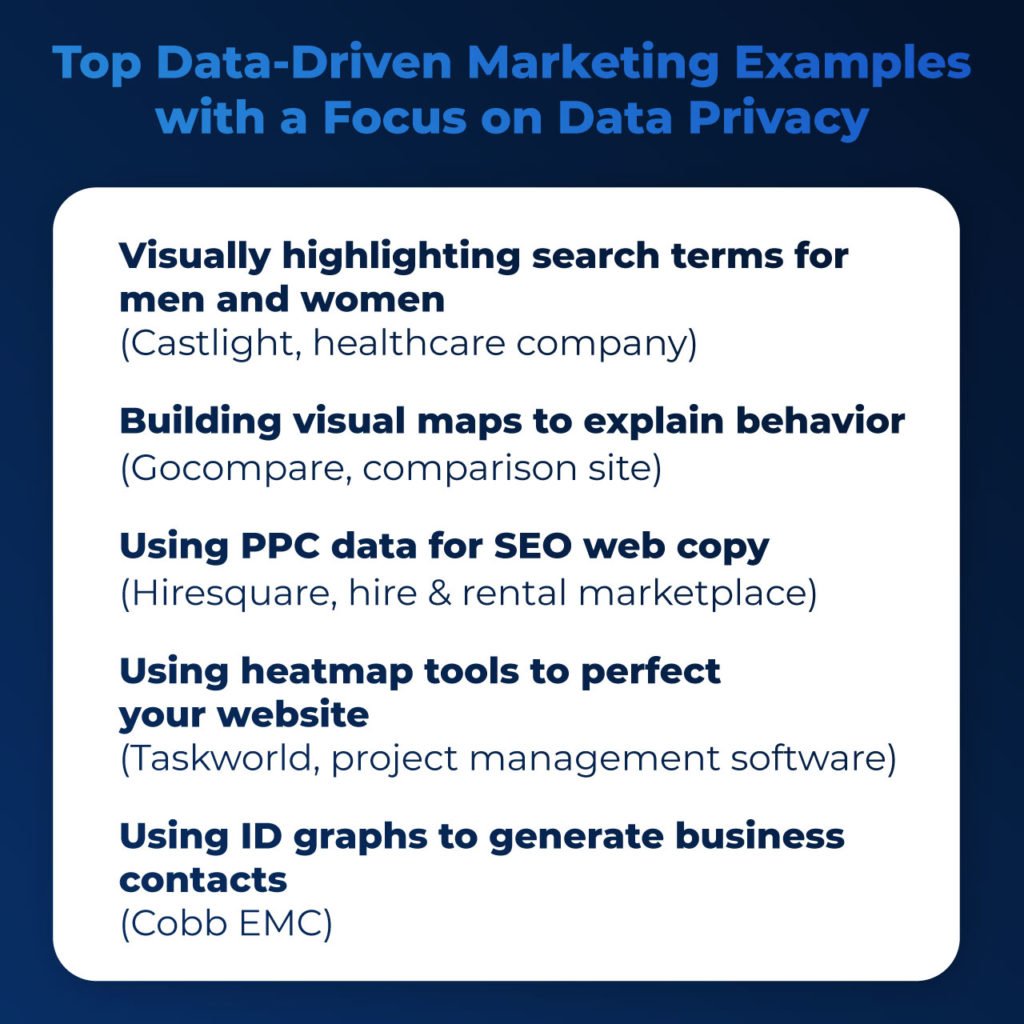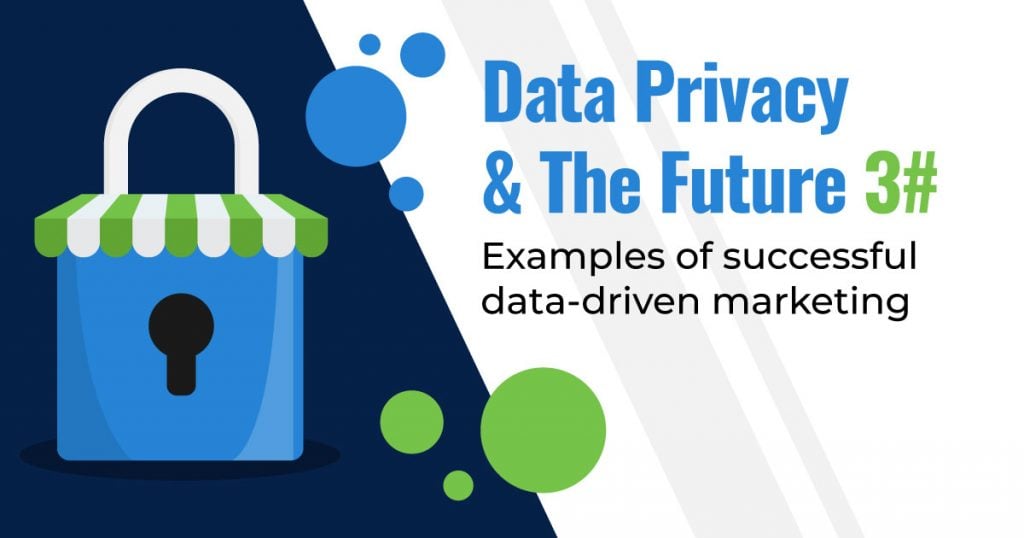Data-driven marketing can seem overwhelming when you consider the volatility of current market landscapes and tough data privacy laws. After all, 87% of study subjects said they wouldn’t buy from a company they did not trust to protect their private data.
The good news is that you don’t have to reinvent the wheel to successfully execute data-driven marketing campaigns that comply with data privacy laws. There are countless examples of how companies have made the shift and left the competition behind – you can too!
We hope that you have read our article on the “Top 3 Things you can do for Successful Data-Driven Marketing in the New Normal”. Now it’s time to look at 5 real-life examples so you have a proven blueprint to work from.
The Best Data-Driven Marketing Strategy Examples Out There

1. Connect Search Terms to Demographics
Digging through search terms to find patterns can be confusing without a plan of action. But did you think about paying attention to the words used for the same searches by different demographics? Figuring out the optimal language for each segment of your customer base helps send marketing messages that have a higher chance of engagement.
A cloud-based healthcare company called Castlight built a map that visually highlights the search terms of men and women. They discovered that women generally used the medical version of words like endometrial ablation and colposcopy. Whereas, men were more likely to type natural language terms such as tooth or rash.
Armed with this knowledge marketers can use the most effective wording when selling gender-specific products across all distribution channels. Mapping the words to the right gender is easily done using CRMs. The trick is digging into the data to find the right words and match them with the demographic that will respond. You’ll end up with higher conversion rates and receive a bigger return on your marketing investment.
The interactive search term map also revealed generational differences. Customers in Southern states are more likely to look for weight loss solutions, while millennials are more likely to be looking for anxiety disorder and dental care products.
Why does this matter? Because it helps stretch a limited budget to the max. You no longer have to market to large segments of the population aimlessly. Instead, using the data you can pick winnable fights. Or, in other words, this is data-driven marketing at its finest, all sprinkled with data privacy to protect users’ information. A win-win for everyone!
2. Create a Map That Explains Behaviour
Too many marketers rely only on what’s going on online by focusing on social media and website metrics. However, tracking customer behavior in the physical world can help you decide what they will do online.
For example, Gocompare, a British price comparison website, built a visually easy-to-follow map of why people moved to the UK. Reasons include going to university, for work, and retirement. Understanding why people are moving between places allows you to figure out what needs a population might have in each location.
Let’s say that in a town you’re targeting there is a boom of elderly people coming to retire. Therefore, it makes sense to market products aimed at this demographic. The visual representation map would be represented by differently colored dots. This might help you see patterns that you would have missed by looking at the data on a spreadsheet.
Additionally, running customer interviews (online or offline) can also help you gain a deeper understanding of what your customers actually want, need, and think. It’s a bit of extra effort, sure, but absolutely worth it precisely because it will help you connect the dots, fill in the gaps, dot the I’s, and cross the T’s on all the data analysis you have on hand.
3. Use PPC Data For Insights
Starting with a new marketing channel from scratch is scary. What if you lose the first $1,000 or $10,000 that you invest with little return? It would be a nightmare scenario, but one you can avoid by merging your data marketing efforts from different channels.
PPC data can be a valuable source of information when branching out into new channels. For example, let’s say you are creating a new landing page that you want SEO optimized. Most marketers would flock to their favorite keyword research tool. They would search out good keyword candidates based on traffic and competition. However, that data is only estimated, whereas PPC data is first-hand information that you can trust.
Rick Vugts, the founder of Hiresquare, shares that they utilized PPC data to create web copy for SEO. They were able to use accurate search volume and the keywords that people actually searched for.
If you’re already doing PPC marketing for your brand, then this information is essentially free. The work is organizing the data for different departments that are tackling new marketing channels. Whether you’re doing email, content or video marketing, you can use the keywords to get more out of new channels. Effectively giving you a head start and a better chance of turning a profit by shortening that teething period.
PPC campaigns also teach you about the search intent of keywords. From conversion rates you can determine what keywords have a commercial intent, where users are actively looking to buy. On the other hand, you can also spot information intent queries where directly going for the sale is not the best approach.
Note that PPC marketing does not need to be the starting point for the data collection. You may collect data from content marketing by figuring out the highest-ranking articles. Then you can use the relevant keywords to start experimenting with new PPC campaigns. Not starting from ground zero allows you to justify spending money in new marketing channels.
4. Use Heatmap Tools to Iron Out Your Website Kinks
You can invest big into a new website with a team of the best UI designers in the world, but it won’t matter if your customer base is not happy. Fortunately, you can use heatmap tools to use visitor data to find where customers are having difficulties.
Here is the type of data heatmap tools provide:
- Visual maps of where the visitors moves the mouse, which indicates hotspots
- Scroll maps that show how far down the page people lose interest
- Confetti maps where you can see individual clicks
Using this data combined with time spent per page, bounce rates, and other metrics allows you to see where people are leaving the sales funnel.
For example, a project management solution company called Taskworld added a heatmap tool to their sign-up page. It revealed 3 issues, which are underused CTA, the later fields got less attention and the Select Time Zone field was not working. The errors were patched and the conversion rate increased by 40%.
Don’t forget to update your Privacy Policy page if you are using a heatmap tool on your website. Also, as a gesture of good faith, you can have a section on your website that explains how you are using heatmap tools and why. It should not be an issue because heatmap tools do not record any personal data about individuals. These tools are used to create averaged data sets that give you an overall picture.
5. Generate Business Contacts from ID Graphs
Creating an identity graph for customers visiting your website can be the backbone of your marketing campaign. The advantages include:
- Control, security and flexibility over your data
- Single customer view improvements
- Cross-device attribution
- Online and offline customer engagement
- Add to the personalized customer experience
Cobb EMC, is an example of a non-profit electric utility company using ID Graphs to personalize messaging to boost email marketing success. They segmented their audience based on interests and sent marketing messages that had better targeting. The result was an open rate increase from 34% to 56.7% and a 9% increase in clickthrough rates.
However, the data can also help businesses locate contacts in their industry. Let’s say a company visits your website for more than 5 minutes. It might be that they are researching and are interested in doing business. Having access to that information allows you to be proactive and reach out to them.
The data can be used to create account-based marketing, where your efforts are focused on a sales team member of the target company. It means you can laser-focus the marketing efforts and keep costs down while getting results.
You’ll need to add visitor ID graph software that can collect website visitor data. Then this data needs to be organized and funneled to the right people on your team. You’ll need to be upfront about why you are collecting the data and take steps to keep it safe. Multiple high-profile tech giants have broken data privacy laws, which are examples of how not to handle customer data.
Final Thoughts
The above examples are just a taste of the data marketing possibilities that you can achieve with your business. With elements such as heatmap tools, ID graphs, search term data, physical behavior maps, and cross-referencing data, you can win in any marketplace. The trick is to be creative and pay attention to the data that other marketers are ignoring.
You don’t have to be scared or play it safe in the new normal. Instead, invest in out-of-the-box data marketing to win the next sale and grow your brand to new heights.



